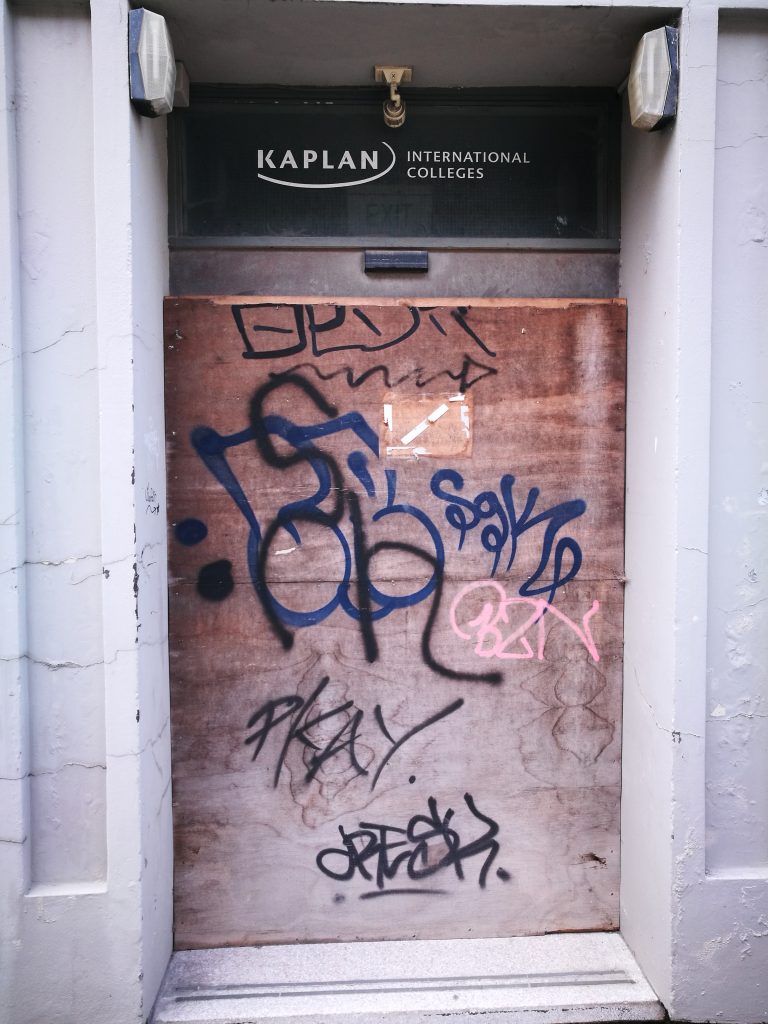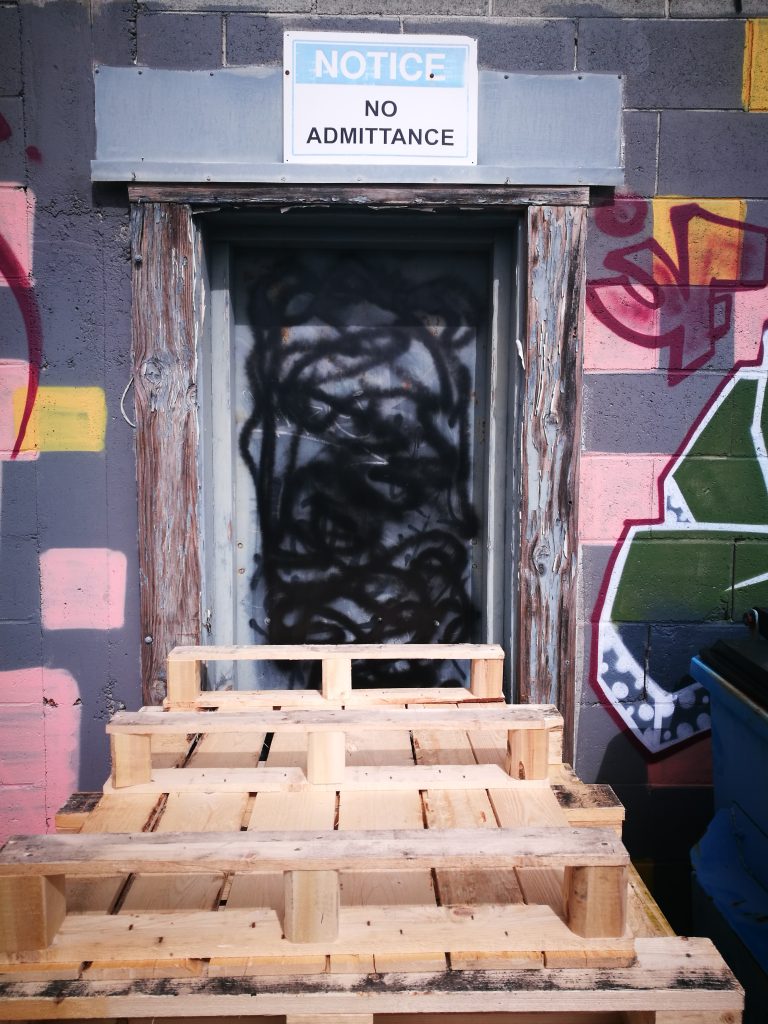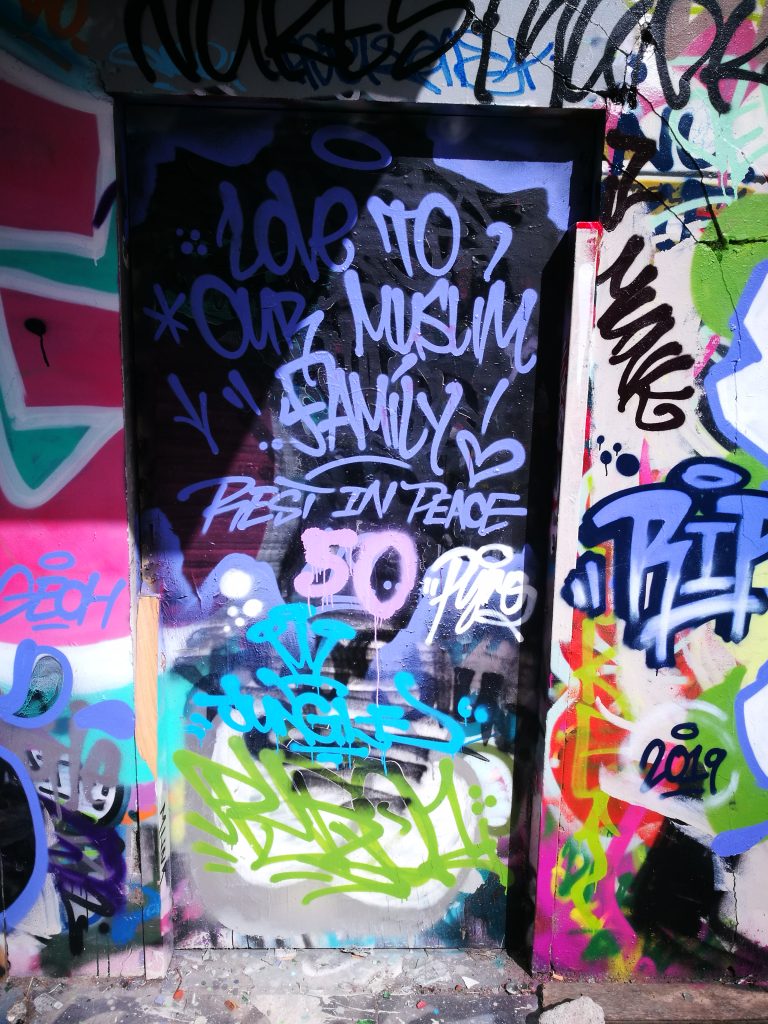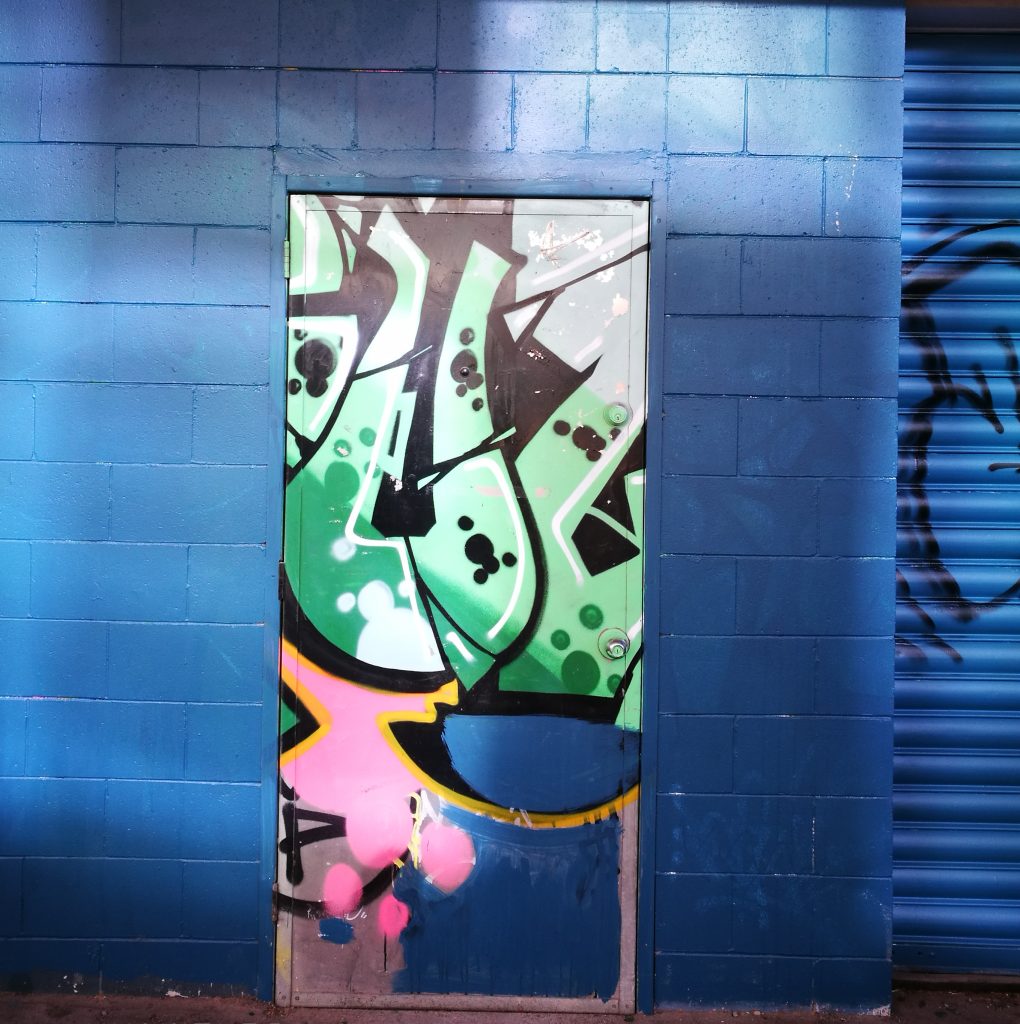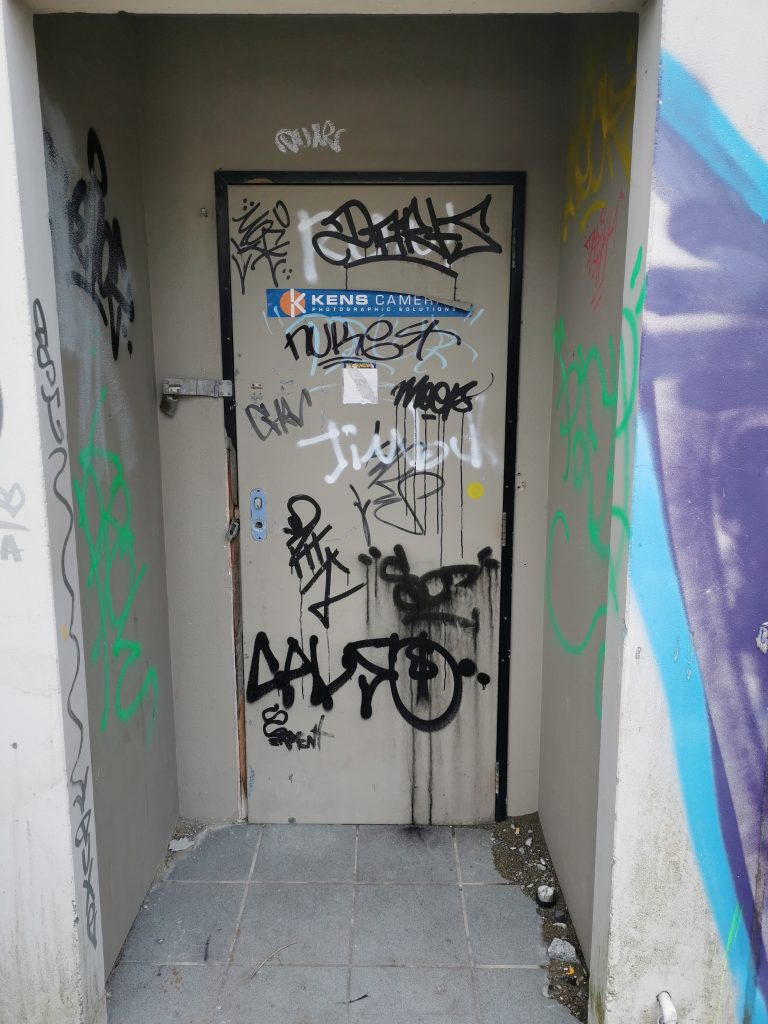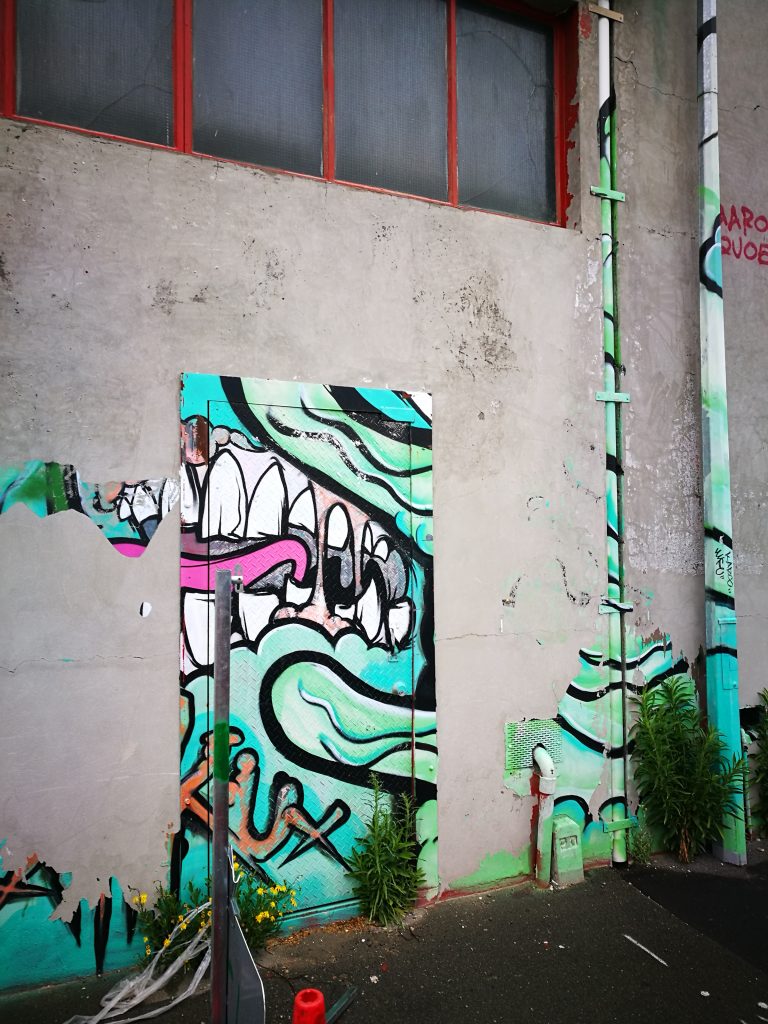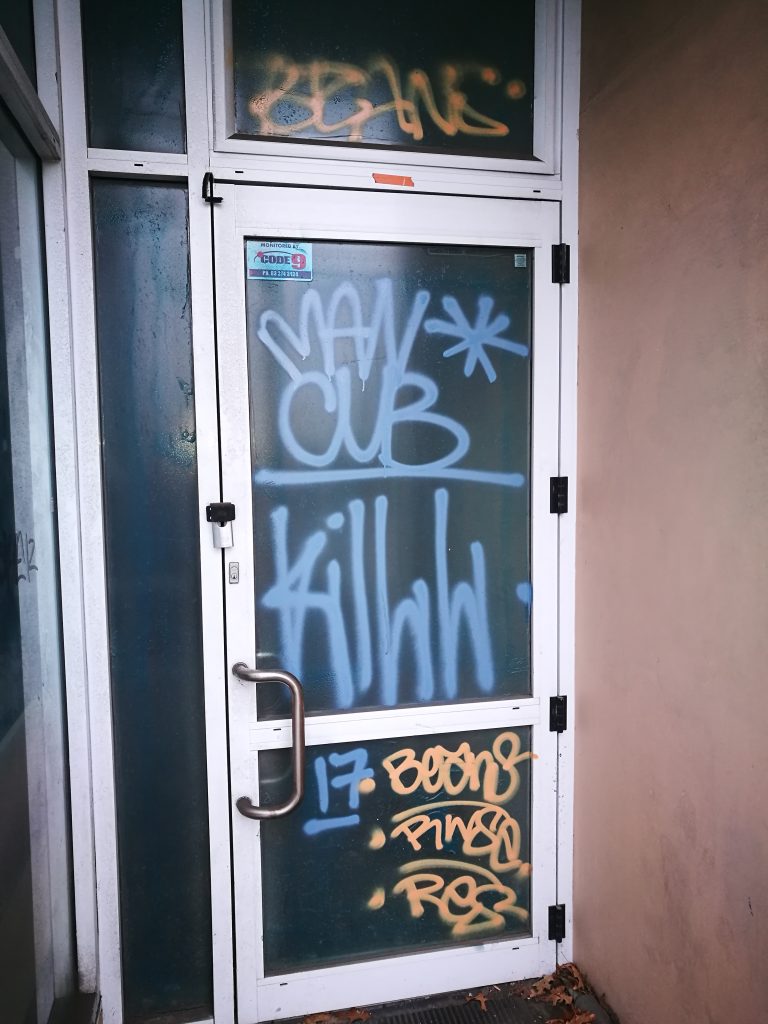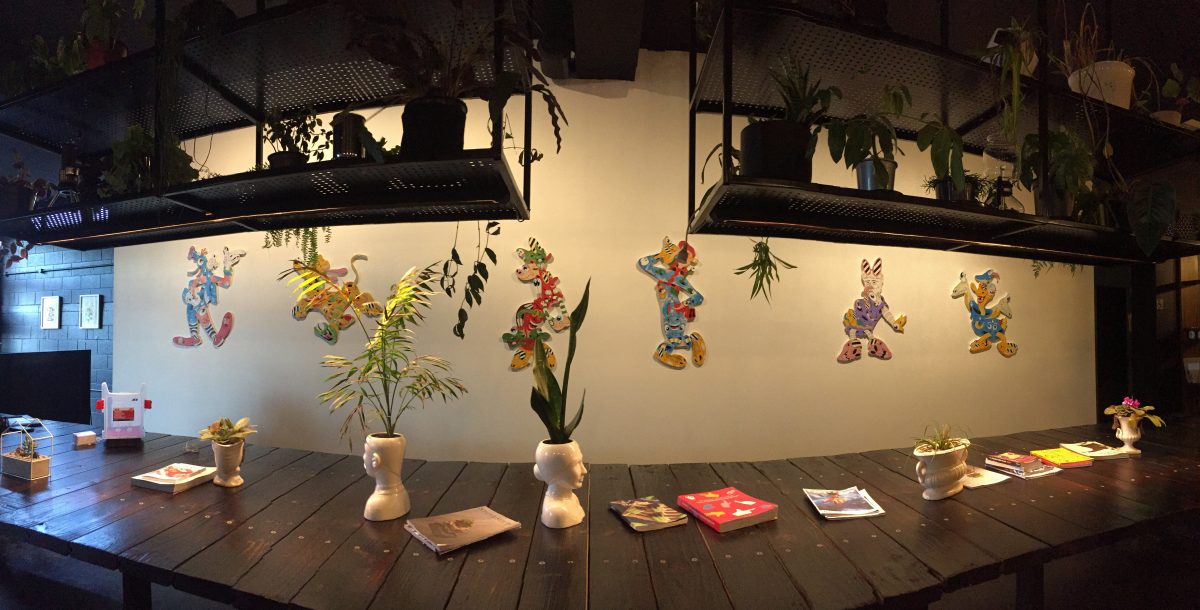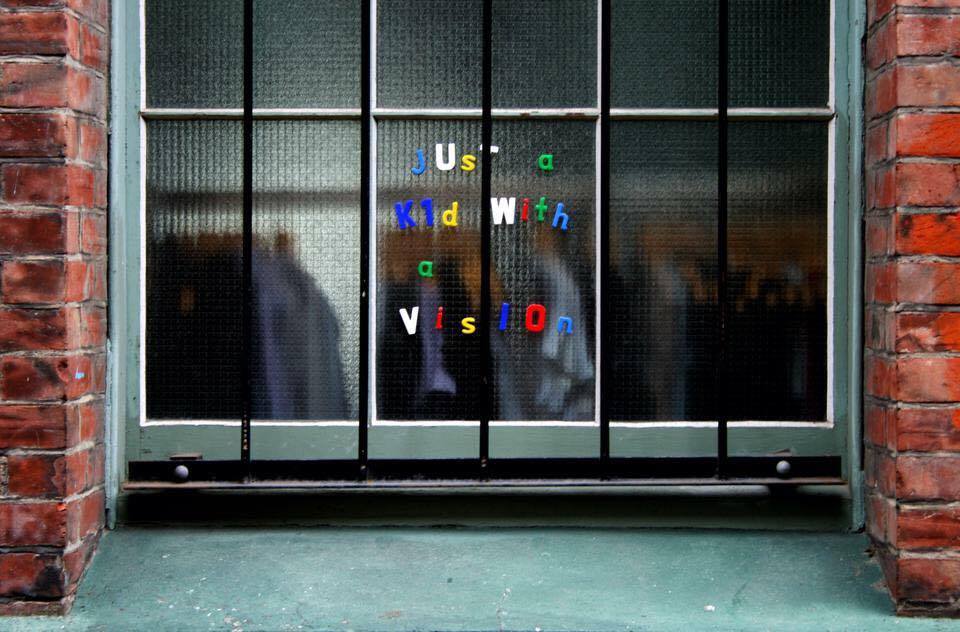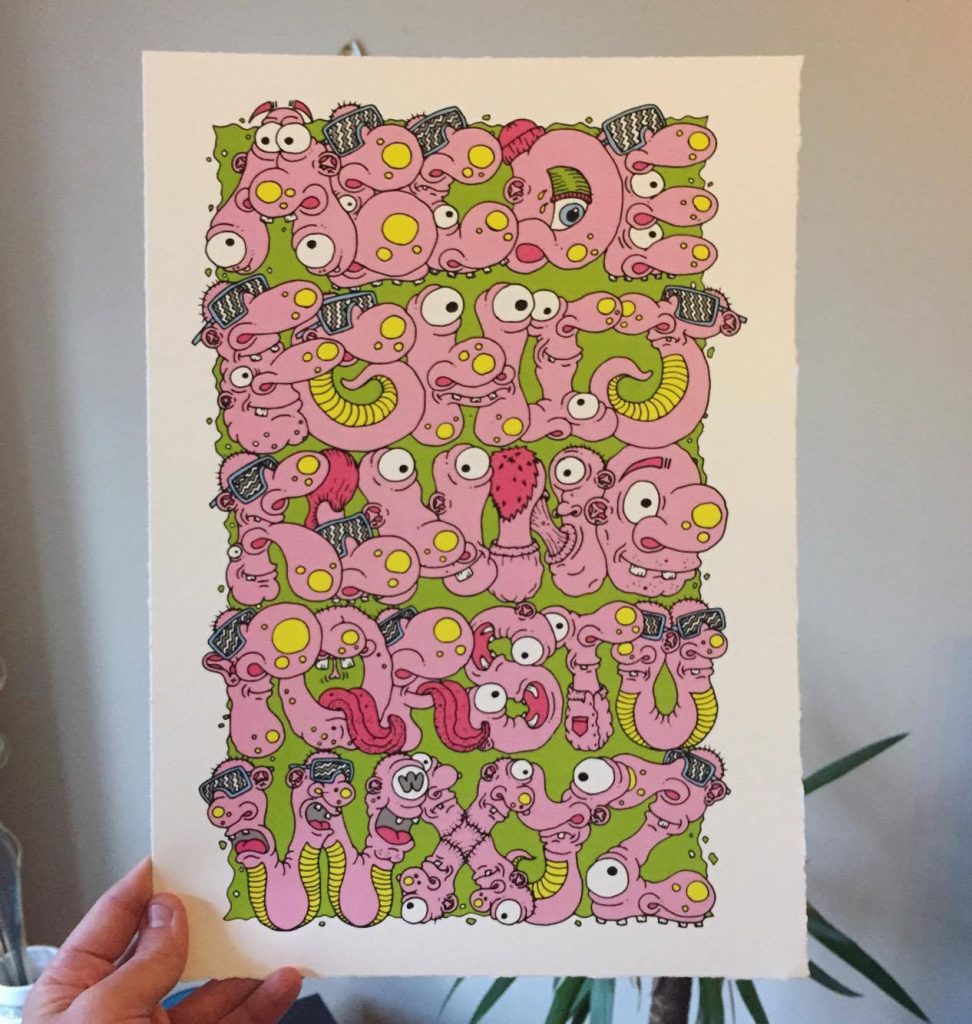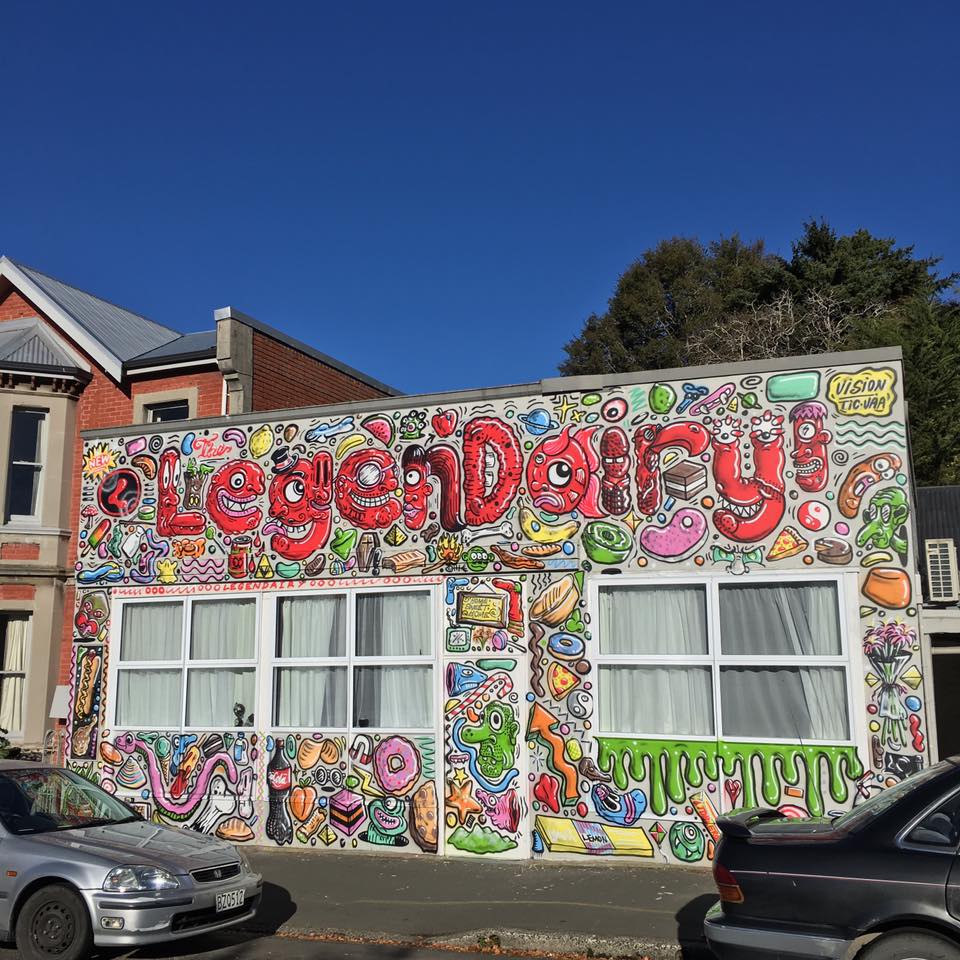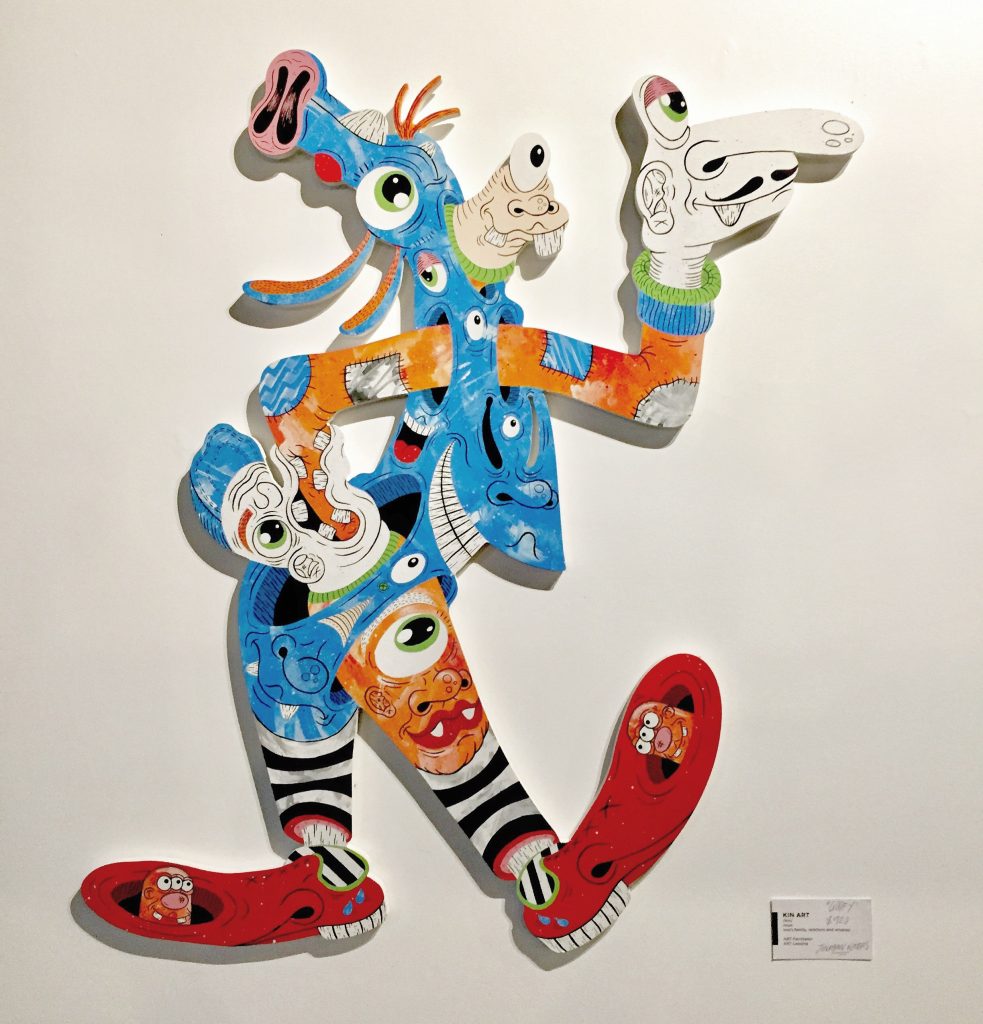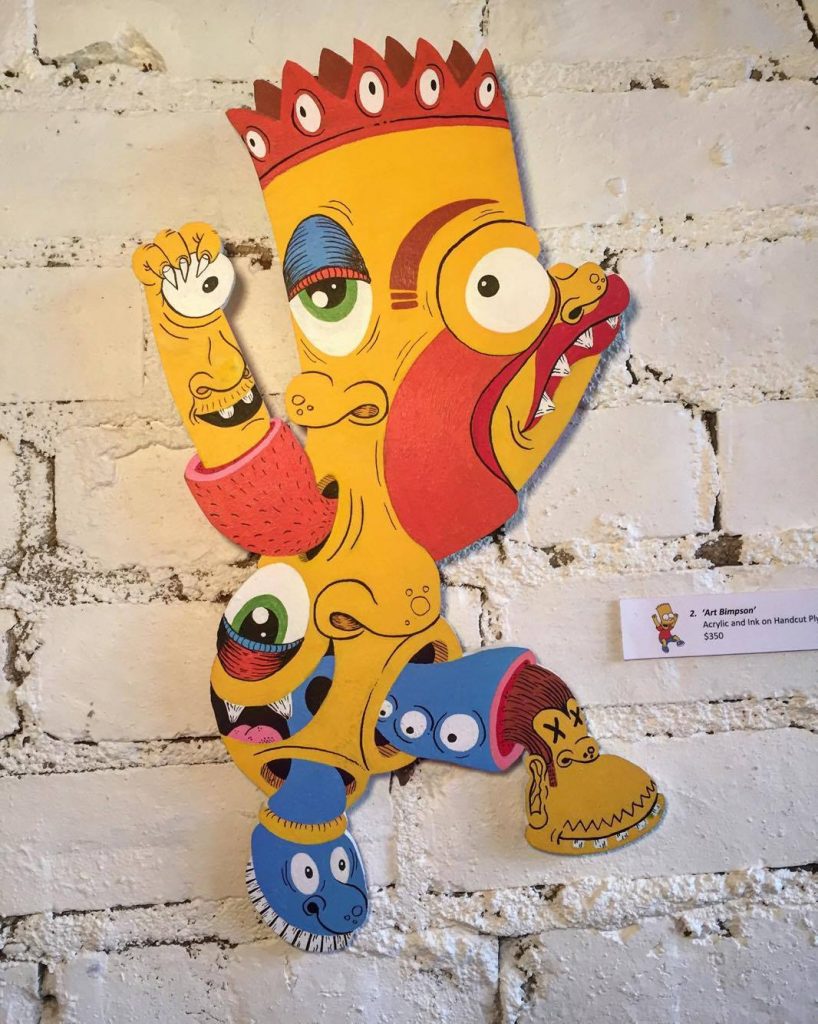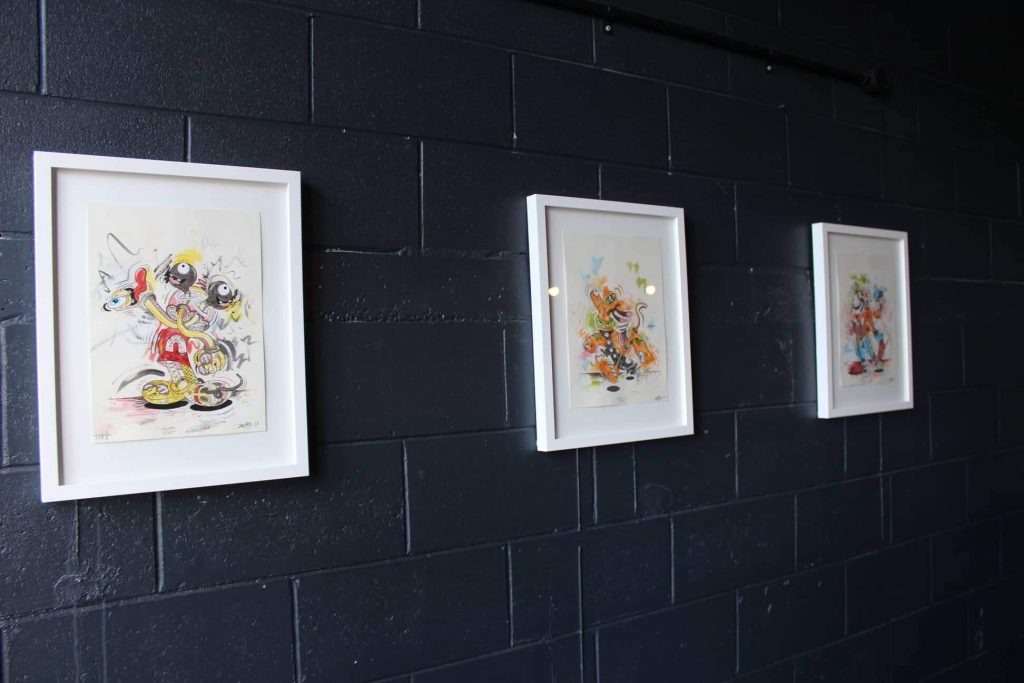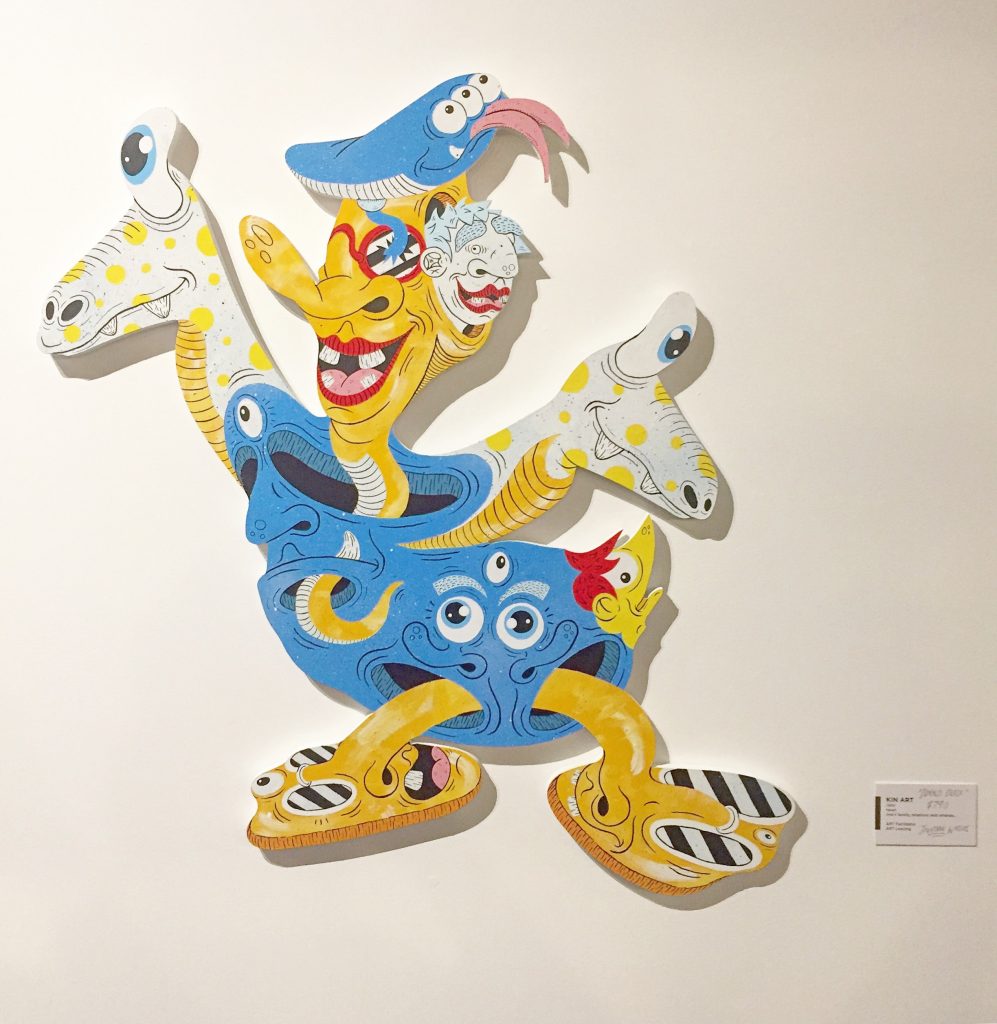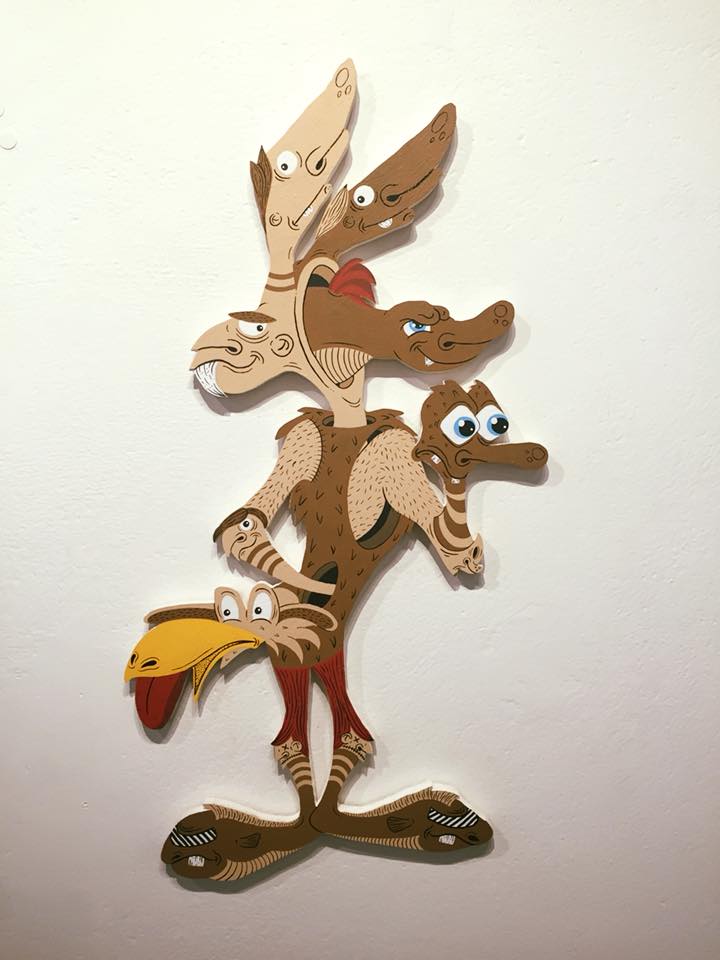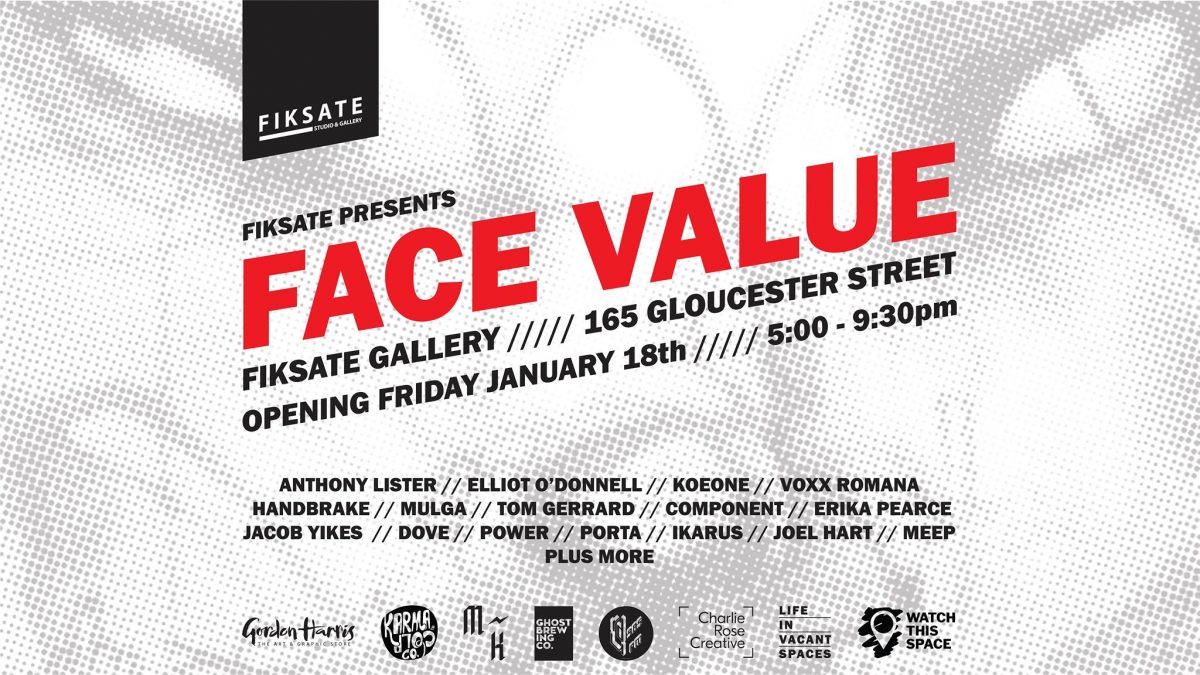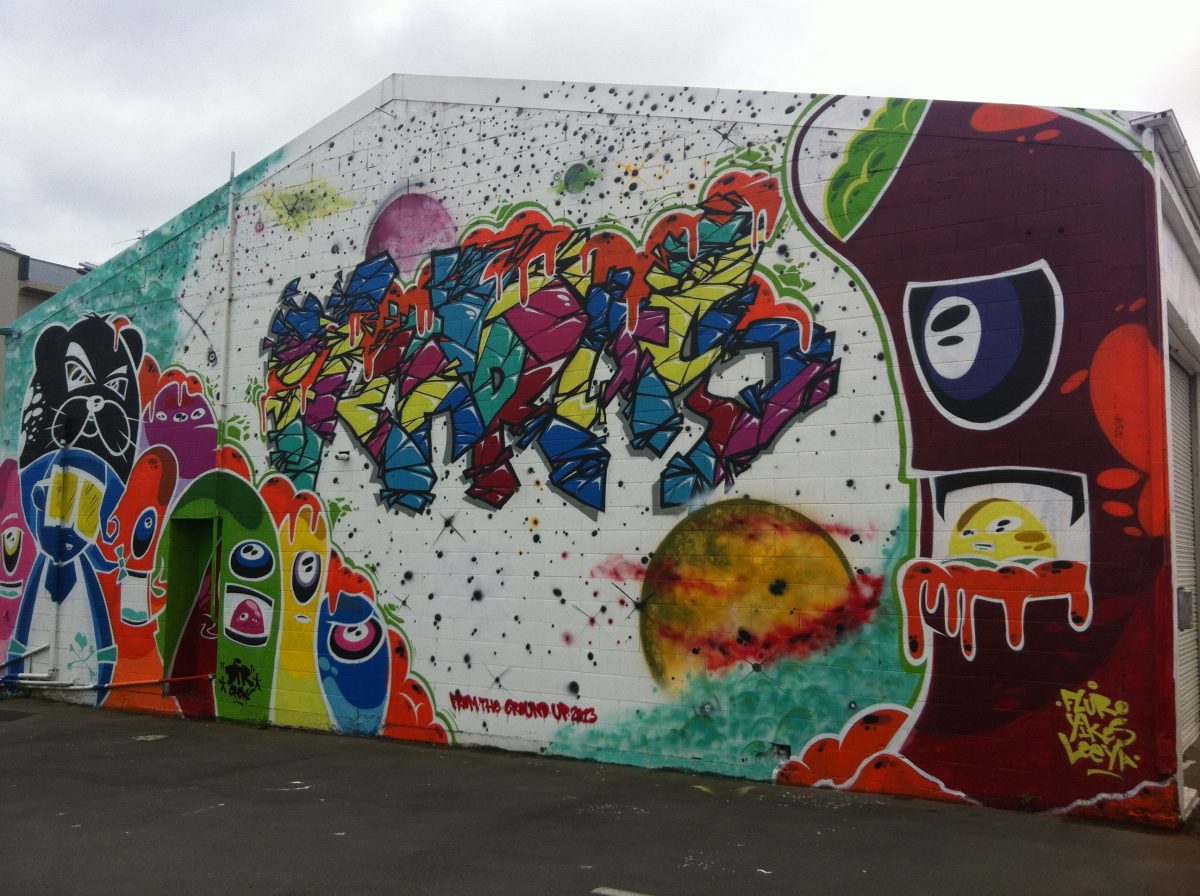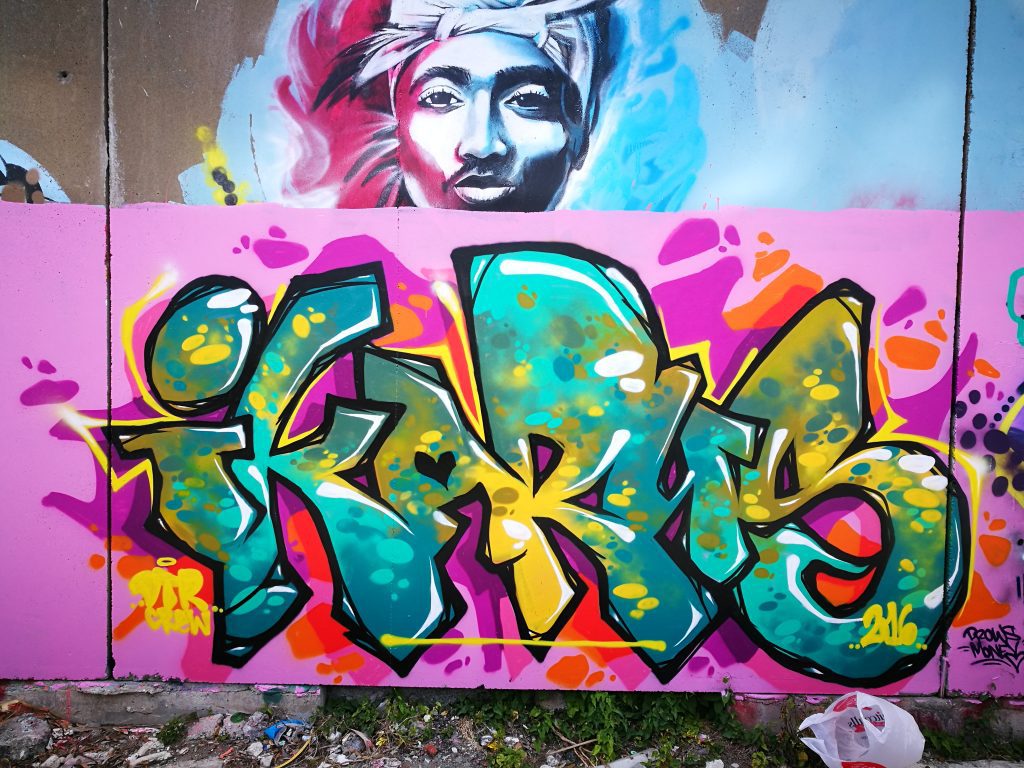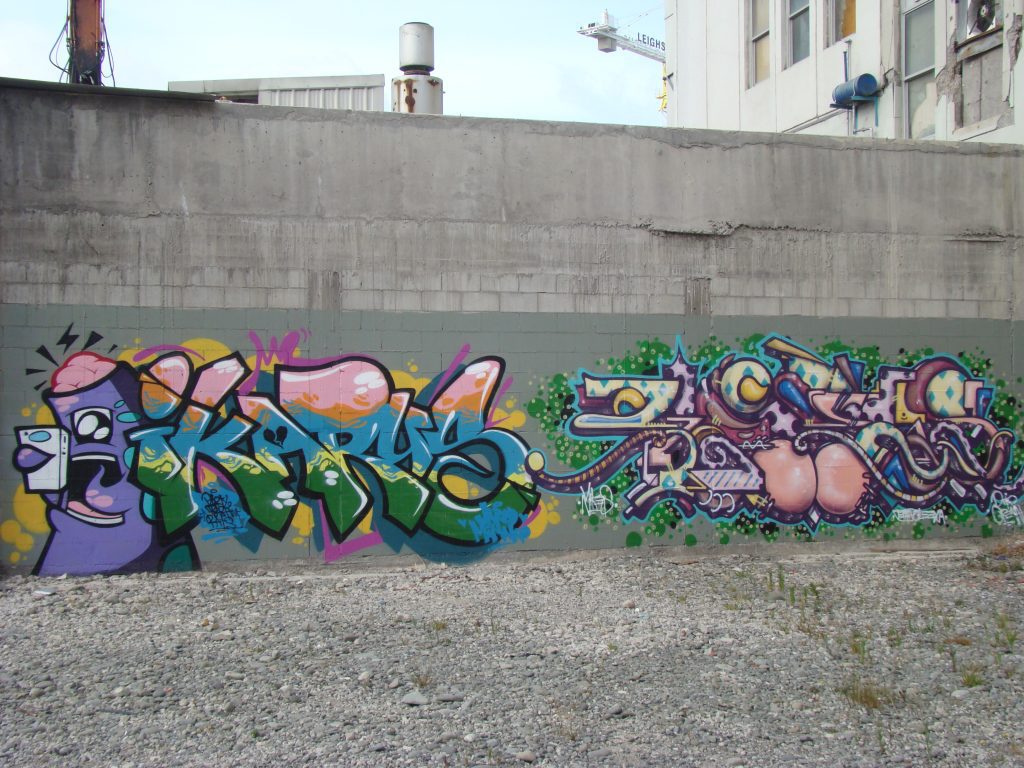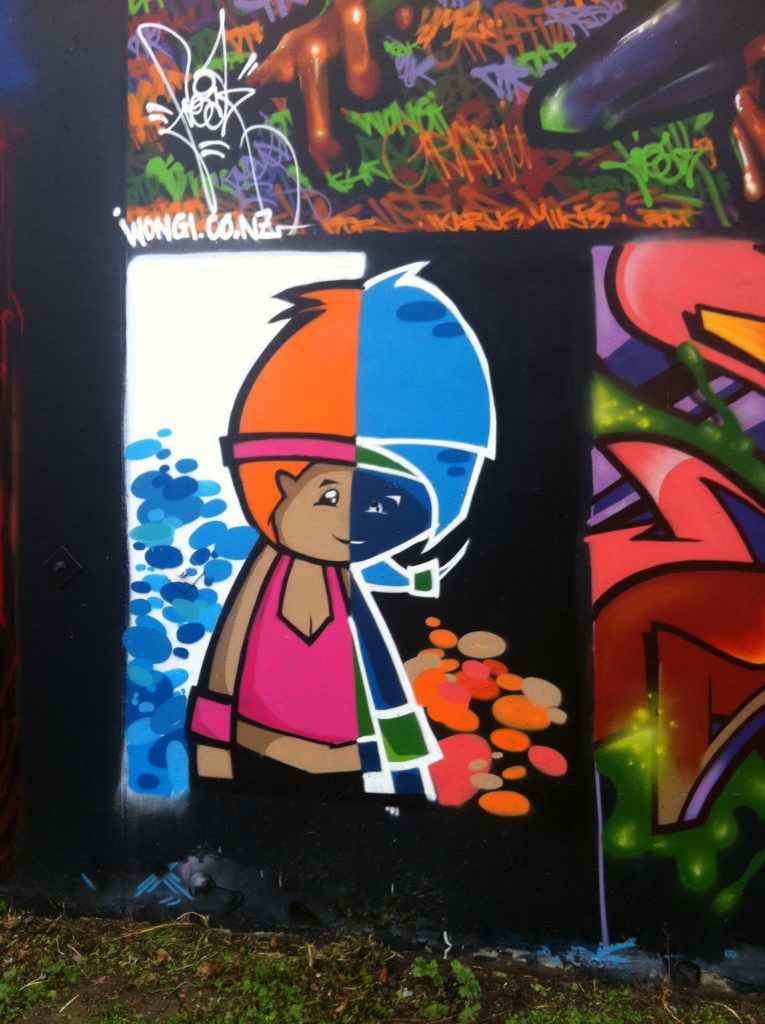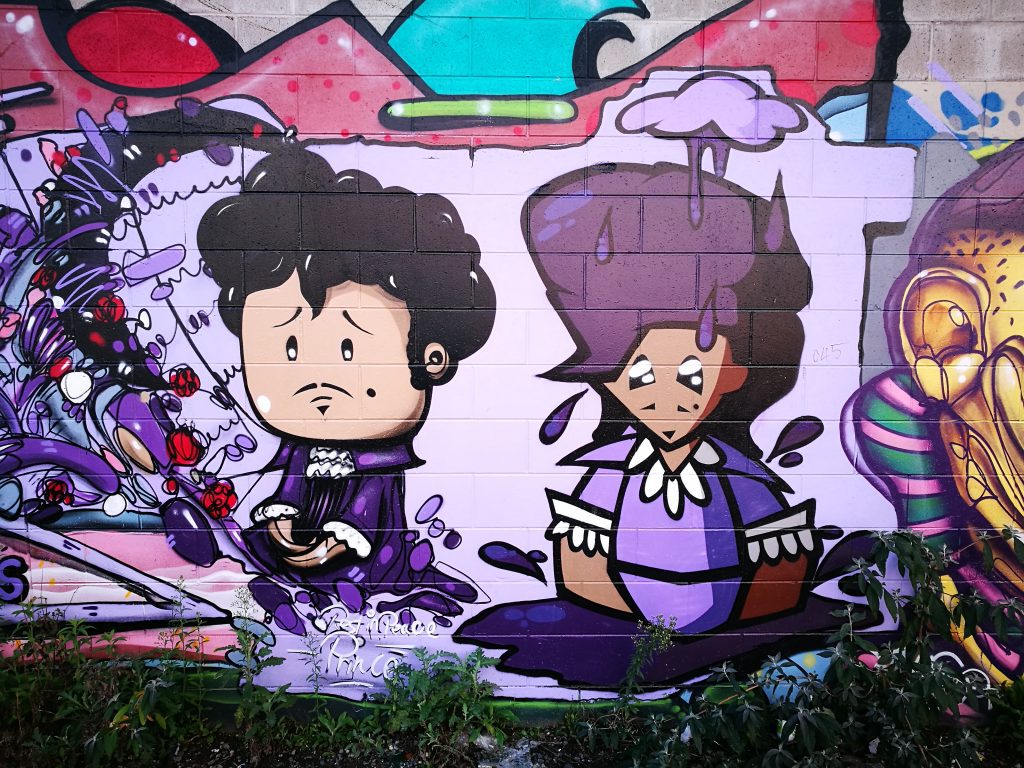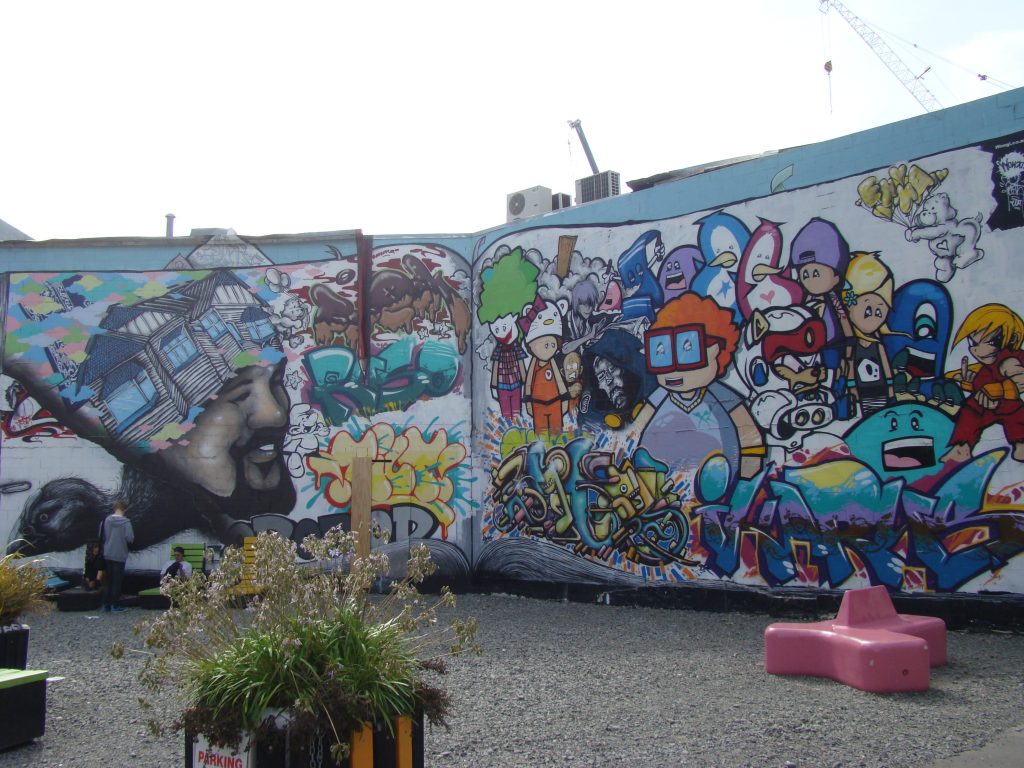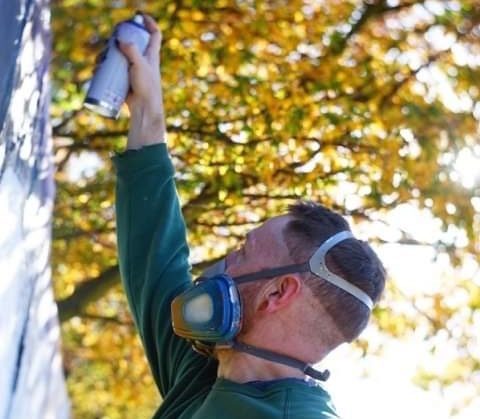
Earlier this year I received an email connecting me with Bulky Savage, a New Zealand-born artist living in Berlin, who was seeking a wall to paint while home visiting family. We traded some messages and attempted to find some options, but ultimately it appeared that nothing would quite line up. Intrigued by a Kiwi artist now based in an epicentre of urban art, I dived into his Instagram to become familiar with his work. His quirky menagerie of characters, seemingly indebted to the influence of cartoons, were immediately endearing, while literal washes of colour added vibrancy but also a suggestive symbolism. Imbued with a sense of playfulness, they were equally comfortable in the digital illustrative realm as they were on the streets.
Fortunately, B.S. was finally put in touch with the owners of Riverside Market and before returning to Germany, finally got the opportunity to produce a mural to mark his temporary homecoming. The wall painting, featuring one of his recurring hollow-eyed skull characters and a flow of colour echoing sloshing paint, is on a somewhat secluded wall in the laneway beside the bustling market. However, that seclusion doesn’t stop it from being a striking sight once you are introduced, beguiling in its seemingly open narrative, with confectionery-esque colours set to flood the ground.
While we had only exchanged brief pleasantries via email, when we finally chatted face to face (or at least via a Messenger call, as is the way in these pandemic times), it was quickly apparent that B.S. was instantly affable and an hour quickly passed. We discussed Berlin, his entrance into the street art world, his experience here in Christchurch and importantly, the state of the world and the modern economy…
While I’m sitting here in Christchurch, you are in the morning sunshine of Berlin, how did you come to live in Germany?
I grew up in Auckland. my dad is English but has been in New Zealand since the late seventies, and that’s kind of how I managed to be over here, with that [British] passport, but who knows how much that’s worth anymore…
So, at what age did you leave New Zealand, and what drew you to Berlin?
I turned 23 very shortly after I left New Zealand. I just wanted to get out. Our tiny little home in the middle of nowhere is great, but it is very hidden away, so I just wanted to see what was going on in the world. Europe was obvious and I had the passport, so that made things a bit easier. I wanted to learn another language, so I wanted to go somewhere in Continental Europe. I bumped into a bunch of German people as I was leaving New Zealand and again while I was travelling, and Berlin came up. It was always a blip on the radar, but I didn’t know anything about it except that it has always had good music. But by my second day here, I was just like, yeah, this is cool, I could do this for a bit. I did spend two months living in London when I ran out of money. I couldn’t get a job in Germany, so I went to London and worked for two months and squatted and got some cash together before settling here.
My impression of Berlin was that there is a palpable energy to the city. It was busy and there was a grit that wasn’t evident in Munich, for instance.
There is a little bit of everything here in Berlin, something for almost everybody. You either love that chaotic kind of energy like you said, or you don’t, certain people just don’t get on with it, but yeah, it totally grabbed me. I never really had a trajectory until I got to Berlin and saw the street art everywhere, and I was like, this is where I need to be!
So much of Berlin’s history can be seen and felt in the streets. The streets speak in many ways, re-presenting different eras and epochs, and that lineage almost informs the graffiti and street art in Berlin with a potency that some cities lack. While muralism is often charged with complicity in gentrification, in some ways urban art itself has been gentrified, but in Berlin it felt different.
Yeah, I guess that is always one of the conundrums of being part of this kind of art scene. It does kind of run both sides of the gambit. It is part of the problem and the solution! Berlin was definitely a bubble within it all, at least for a while… Gentrification has become more of a problem recently as the city folds a bit to the mighty Euro and murals do get absorbed into that as well. But yeah, muralism is only one layer of the street art and graffiti scene and there will always be people telling stories from the streets here.
A lot of people have said that Berlin’s a place for lost people. You get a lot of people coming here because they don’t really know what they’re doing with themselves. They spend a couple of years here and then figure it out and go and make money somewhere else. I guess I never got out, I became entangled with Berlin. But it’s become part of my art style and my lifestyle. I guess it’s also spoiled me, I’m not really sure that I could go and do what I’m doing somewhere else, in the same way anyway.
You explore a lot of different creative activities, so how would you describe what you do? Do you define yourself by any particular discipline or medium?
I like to say that I’m an artist who does street art sometimes. I bore easily, but if I’ve got different things to play with, I can always move on to something else. I really like photography, but everybody does photography, so it’s a much more difficult market to break into. I do digital stuff, and I’m trying to get back into painting with paint brushes again and things like that. But spray cans particularly are my jam. I’ve gotten good with those and its really nice to feel capable with something like that. That’s the problem with being multidisciplinary, it’s really frustrating working with things where I’m almost there, but I’m not really there. It’s nice to work with something where I can be like, bang, bang, bang, it’s done the way I wanted it. That is very satisfying.
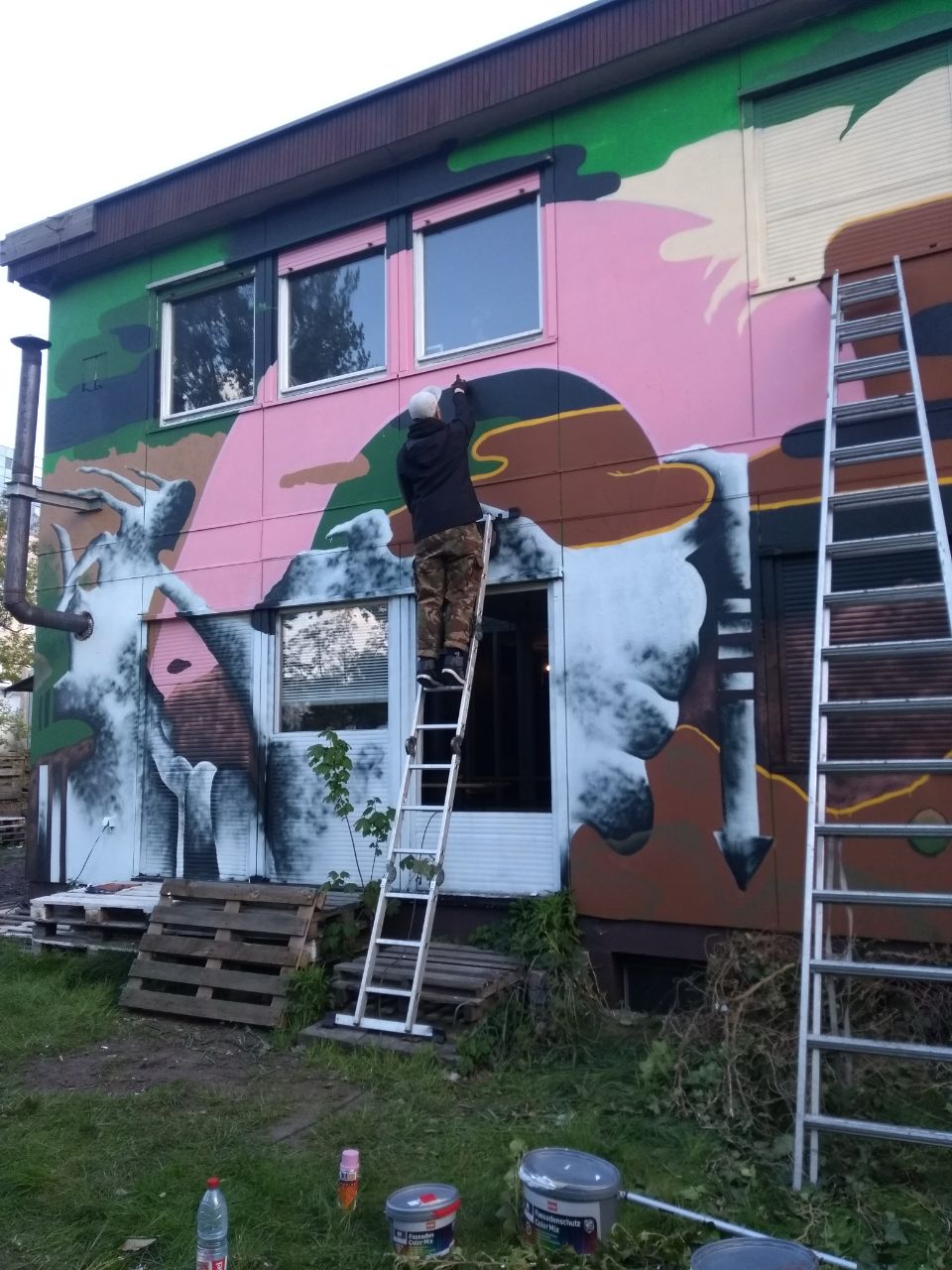
There is something about the material qualities of aerosol that seem a particularly good fit for an urban environment like Berlin. One of my enduring memories in Berlin was stumbling across a Blek Le Rat stencil, it had almost all been painted out apart from the feet of the character and his name, but I always remember being struck by the way that the paint sat on this brittle concrete surface. But there is a lot of discussion going on now with artists about how to balance environmental concerns with the reality of aerosol, is that something that you think about?
Sometimes. There are always concerns with all sorts of different things for me, not just environmentally, but also keeping myself sane, so I have to balance out the impacts that I have with keeping myself happy. That might seem selfish sometimes, but I live in Germany and Germany’s pretty good at taking care of that stuff. There are proper waste bins for spray cans at a lot of the walls you paint these days, which is good. I hope they get taken care of properly, you don’t really know, there’s only so far that you can go when it comes to things like recycling. I can put all my stuff in all the right boxes, but I don’t know what happens after that. I’ve heard that they don’t even recycle themselves, certain things get sent to China, stuff like that. That is completely out of my control, so I try to not worry about that as much. Its great now that they don’t have things like CFCs, I’ve had people come up and say what about the ozone layer, and actually, you know, technology, baby!
Aerosol really informs the entire process, the final image, the process of making that image, even the conception of that image, it’s a defining tool for a lot of artists, and one that is so hard to replicate…
You can’t get that effect with anything else; air brush is close, but it’s also not. I have been working on an exhibition; it was planned for the first week of lock down. I wanted to make smaller scale works, so I’m using stencils, but I had to use spray cans because I want that beautiful gradient and that granular effect that you get from aerosol. There was nothing else I could use that would work like that…
It was initially adopted by graffiti writers primarily for mobility and efficiency, but increasingly, it’s actually the aesthetic that has become the attraction. The mastery that has been achieved over generations has become what drives and defines its continued use. When did you start using spray cans?
In New Zealand there were a couple of people on the periphery of my friends that were getting into street art. Cinzah was best mates with a girlfriend of mine at the time, and I went along to a couple of his shows and he was doing some paste ups and things. I was like, this is kind of interesting. I really love his style, it’s fantastic. But I was already on my way overseas, so by the time I got to Europe, that was really my first proper introduction to spray cans. I think it was maybe two or three years after I got to Berlin that I really started playing around with spray cans, so I guess around nine years ago. They are a difficult tool to master…
You mention the influence of street art, were you attracted to the act of painting in the streets? Often that is the biggest leap, because it is a decision imbued with more significance as you get older, when you’re more aware of a lot of the mechanisms in public space…
I hadn’t considered it before, but when I got to Berlin it was so pervasive, I felt comfortable getting out and being part of it. I just went out on my own. I made some paste ups because I couldn’t use spray cans at the time, but I could draw. I was all about drawing to begin with, I still am to some degree. I’d gone into a little gallery which is not really around anymore, it was run by this guy EMESS, a stencil artist, and I talked to him about the kind of stuff I was doing, and after that I went out and made my own paste ups. I went out with a sponge, totally the wrong gear! One of those pieces was still around recently actually, it stayed up for like eight years, which is pretty impressive for a paste up. Then, finally, I started doing street art workshops and teaching people how to do stencils, and that was when I really started playing around with spray cans a lot more, just taking it from there and putting it onto the walls as well. I did the illegal stuff here and there, but I’m not sure that I would have done it anywhere else besides Berlin. It is a lot more relaxed here than it is in most places. But the illegal side of it wasn’t really a draw card for me. A lot of people, particularly in graffiti, love that side of it, going out, getting into spaces that you shouldn’t, running from cops, that kind of thing. I guess my parents raised me to be a ‘good boy’, or at least put the fear in me! I was much more into the actual creation and painting part of it. I’ve got a bunch of friends who paint trains and things, and it’s great, but I just don’t have that in me. I like taking my time. That’s why I’ve gotten into murals, spending a couple of days painting is really rewarding to me.
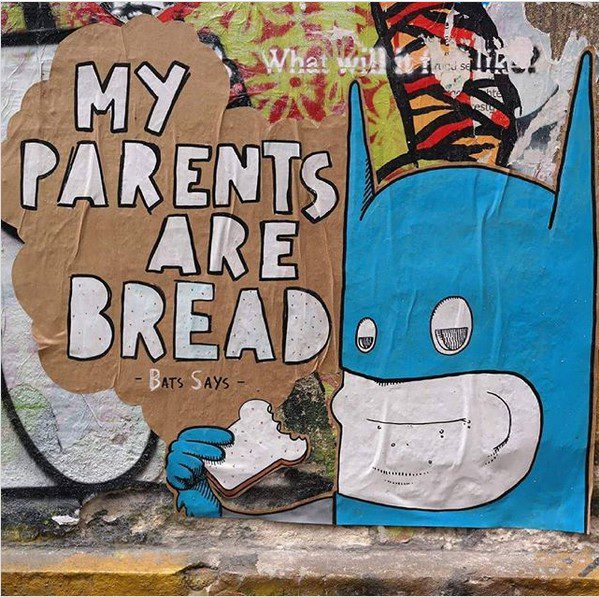
Even if the illegal aspect wasn’t as attractive, were you still interested in how to situate a work in space and the encounter that you can create with an unsuspecting public audience?
When I was still doing paste ups and things, I’d like to have bits on corners of buildings so you could see it on one side and then pop around and there’s another part of it as well, leading people in certain ways. Interacting with outside spaces is a big part of the street art scene, and now, when it comes to murals, I still like that idea. I don’t want to put big messages into my art. I like to just have something that will pop and grab people’s attention, something a bit out of left field that will make them wonder what’s going on there?
Design and illustration are increasingly tied to urban art, as an interconnected pathway and through the iconographic approach of post-graffiti, the creation of an instantly recognizable and relatable icon. Has your design background influenced your work?
I studied design at Massey University in Wellington for a couple of years because I was young and foolish. I basically thought that was how you made money in art. But really, I’m more into the ‘art’ side of things. You can see that my work is very graphic, although I would say maybe more Pop Art these days. But the graphic design thing, I didn’t only do it because of the money side, I love graphic design as well, and it has definitely influenced my style.
There is an unmistakable, recurring quality to your work, notably with the hollow-eyed character, did that develop as an intentionally recurring presence, or was it something that just kind of emerged and endured?
I think I drew the first iteration of that character just before I left New Zealand. I used to work at Cosmic Corner and I did a drawing of that little character one day at work. Characters and cartoons have been a massive influence throughout my life. The Simpsons were my favourite thing growing up, and you can see the shape of Homer’s head in that character. I just kind of absorb things from everywhere. While I was traveling, I started to really develop the characters and then I came to Berlin and that’s when I was like, this is where I can take them. Over the years, I just played around with them and they took on their own personalities. There is the big fat businessman who keeps losing his head, there is the little sad guy, the introspective guy and then the crazy worm guy. They are all sort of similar, and I guess through a slow process I have imbued them with bits of my own personality.
Do they occupy their own universe or are they part of our world? The Simpsons live in Springfield, which is famously never revealed on a map, it is sort of a contained universe, but they are also part of the broader world through storylines and their pop culture status. I guess as soon as your characters are added to public space, they start to occupy our world as well, right?
I have given them this world they inhabit, which is kind of like Springfield, I guess. It’s called Crushington and it is this relatively colourless place. There’s a Crushington in New Zealand as well, which is funny. If you look at some of my line drawings, there’s this kind of desert-like landscape, these big open spaces influenced by New Zealand, where you’ve always got that big horizon line, whether it’s the sea or the mountains. There is also a little bit of Colin McCahon in there. I love Moebius’ style as well, the desert line he uses, I stole that bit. But I like how you were saying The Simpsons are part of our world, but they’re not, because I feel the same with my characters. For the most part they are two-dimensional beings in our world, and I really want to get into sculpture over the next couple of years and bring them into a more three-dimensional form. I want to play with that idea and bring them from their world into ours, because there is this second space they inhabit where they are more like what I know. I haven’t really shared it so much, but I’m going to have an exhibition about Crushington at some point soon…
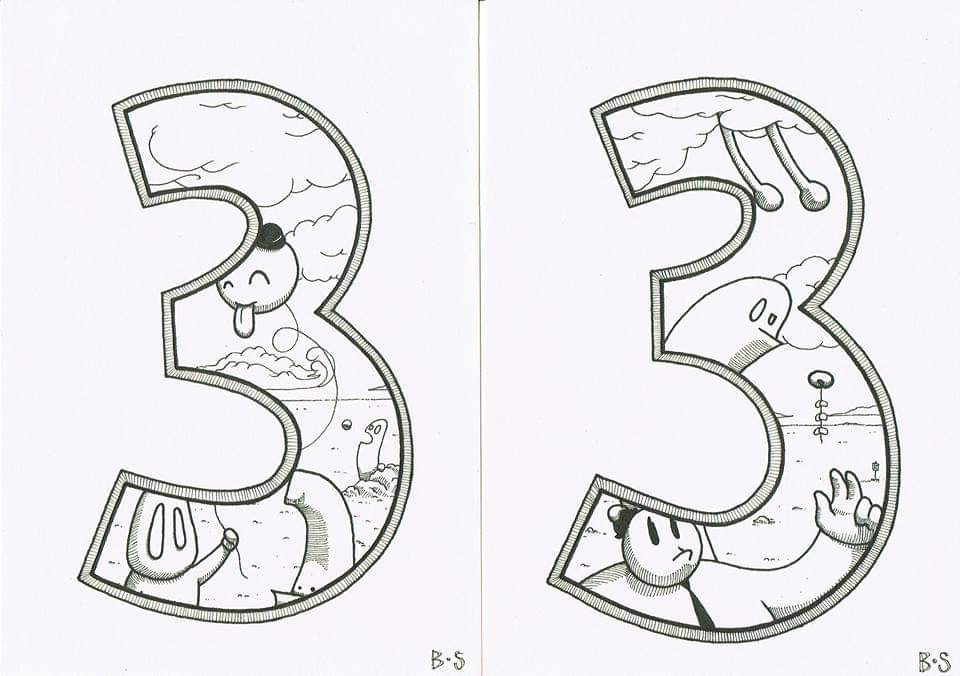
Kaws has shown with his Companions that there is so much potential to explore those three-dimensional incarnations, different materials, various scales, and even playing with the perception of high and low…
That’s one of the things that always drew me to the street art and graffiti world, if you want to do it, you do it. You can take that style, or you can take from there, take from there, take from there, and that’s why I think it’s been such an interesting movement, you have all these people coming from different backgrounds and different influences coming together and making something completely different. It’s exciting…
The waves or oozing colours are another recurring element in your work. Do you want to dive into that imagery a little bit? Metaphorically, of course…
I really started with those in 2017. I did an exhibition called Bit Sick, playing around with the B and the S of my name, and it was about how crappy 2016 was, and how sick I was of everything. I’ve always been someone who just goes with the flow and the waves were an aesthetically pleasing sort of rolling vibe, but also fit with the theme, because in that exhibition I had things about being sick of art, sick of commercialism, sick of America. Of course, 2017 came through and really shat on 2016, and things haven’t really got any better since!
By 2020 you must be more than a bit sick…
Well, you know, it all flows and rolls downhill! The exhibition that I’m working on at the moment, which was going to be out already actually, was very timely as well, it was all about not seeing the bigger picture and being focused on these little pieces, as interesting and attention grabbing as they are. Again, it is making us all feel a bit sick and now quite literally making the world sick. It’s really just about being over things as well; the state of myself, of the world, just expressing my feelings at the time. But there’s not going to be any characters in the exhibition, it’s just going to be the waves. They have become really fun to paint with spray cans as well, the shapes, the really nice blends as well, giving it a sense of solidity, so that’s become more of a focus…
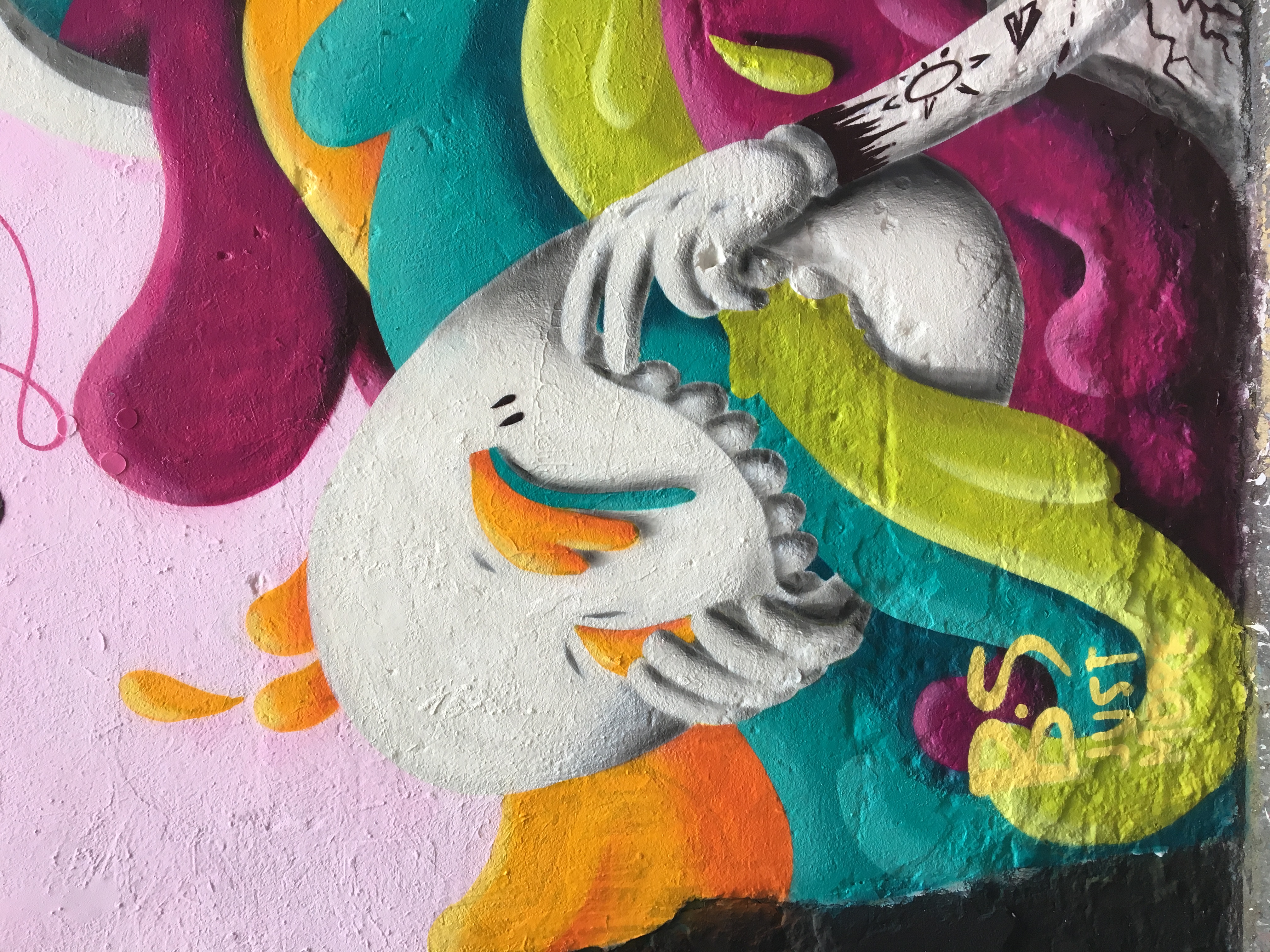
I’m thinking of the idea of a purge, or a cleansing, and once you take away that figure, the idea of size and scale changes. If the wave becomes the sole focus, it becomes something else, right? When you see it come out of a figure, you automatically scale it relative to that figure, when you just see that wave filling an entire frame, that can be either overwhelming or it could just be a close-up of a small trickle. There’s something about that idea of the bigger picture and smaller details, and that social element becomes strangely more pertinent when you take them away from the figure. So, tell me about your experience painting here in Christchurch earlier in the year?
I’d never painted in Christchurch before, but my parents live just outside of Cheviot [a small town north of Christchurch], so when I go back, I fly into Christchurch. I would just get to see little bits of it as we drove through, or if we visited somebody there. I remember going there when the city center was still completely locked down after the earthquakes, but this was the first time I got to spend a little bit of time in Christchurch for some years, and it was cool. I saw a lot of opportunity there, personally, as much as the earthquakes were terrible, I love seeing old destroyed buildings, maybe that’s why I’m in Berlin. It’s not something that you really get to see in New Zealand, so I really liked that. I liked the show of power, but then also how the city has risen up from the ashes of it as well. The city is really interesting at the moment.
I found it incredibly interesting that Christchurch became this microcosm of a big city; you had shiny new buildings, you had broken buildings standing there empty and covered in graffiti, becoming spaces for people to explore. Different people could do different things. If your mindset was to explore those broken spaces, you could do that, if your mindset was to sit in a bar and drink a cocktail, you could do that. There was this interesting juxtaposition of old and new and broken and shiny. One thing that does is reveal a lot of the power structures that go into making a city. Christchurch has become interesting in that regard, and graffiti and street art have a role here as both dissenting voices and part of the rebuild as well. It shows why these forms of art have become such a dominant visual voice the world over, because they can adapt to different environments. How did the mural in Christchurch come about?
In a very winding way. Knowing I was coming back to New Zealand mid-last year, I started reaching out to people in September or October, mostly through Instagram. I got bounced around. I got in touch with Preston [Hegel] down at The Exchange, he was doing some cool stuff and was like, oh maybe you could talk to this person… I got bounced around between a bunch of different people before I got put in touch with the guys from Riverside Market at the last minute. I just said I’m going to be coming down in like two days and they said: Sure, we’ve got a space, you can do what you want. It just fell perfectly into place. I was slightly freaking out that I wasn’t going to be able to get a space to paint, and coming from Berlin, I was just like, what is this?! Where are my walls?! In Berlin, if you want to paint, you just go and find a wall. I have a wall that I can just go and paint anytime I want just down the road. I wasn’t necessarily looking to leave a massive mural, I just wanted to find somewhere to paint, if it could stay that would be a bonus, if not then c’est la vie. It worked out great, those guys were really nice, they were just like: What do you need? Here’s money for the paint. They paid me for it as well, which is fantastic. It was this very last-minute design, because I was like, let’s see what the wall’s going to be like and go from there…
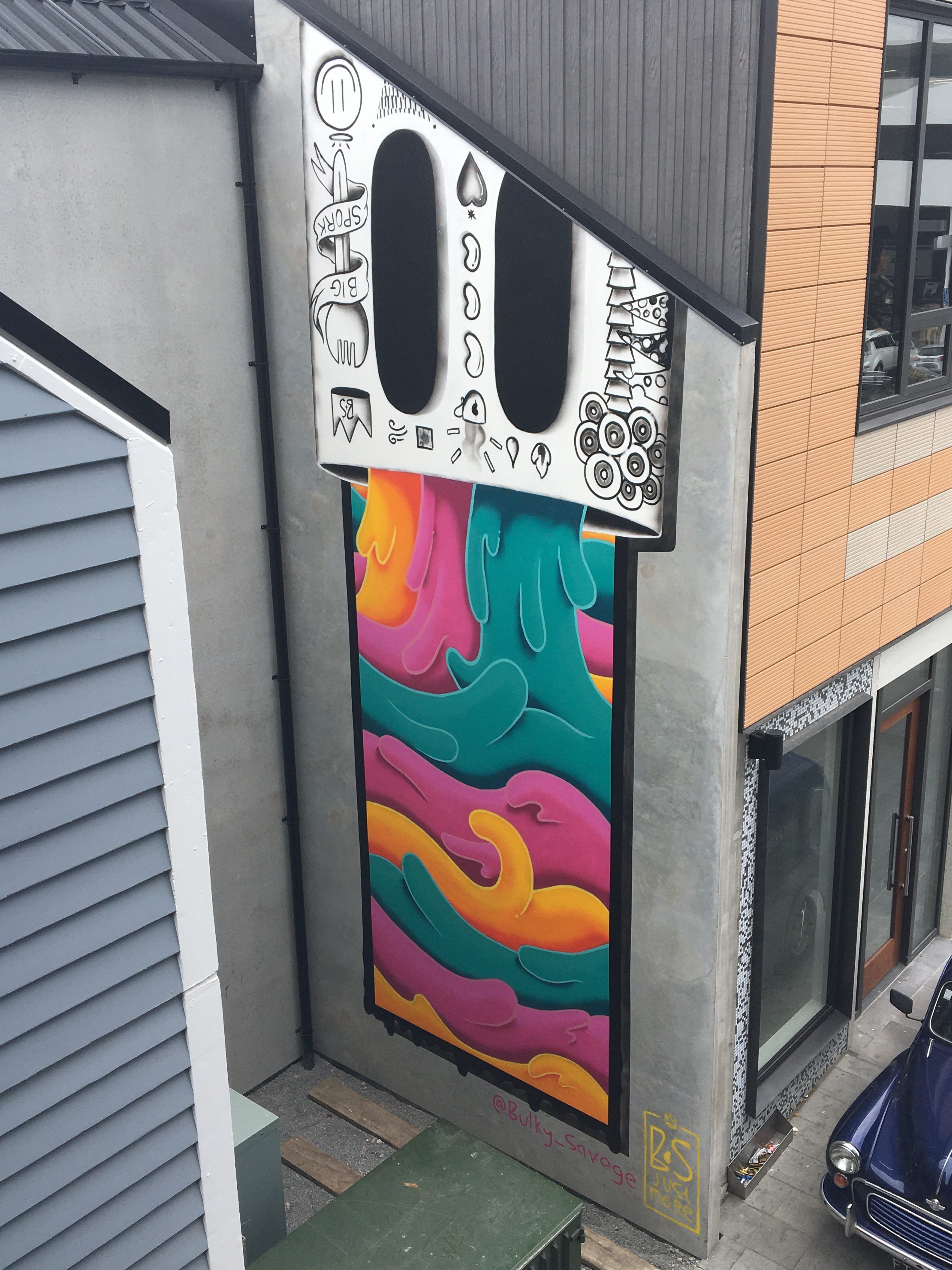
The wall is quite high and relatively narrow so that obviously played into the design and I guess allowed you to use those recurring motifs in what seems like a natural fit…
Well, I had ideas floating around in my head of what I wanted to paint. I’d actually thought of having it the opposite way around, with the character at the bottom and all this stuff coming up out of it. But there was this big generator at the bottom of the wall, so I just flipped it around. Most of the time I tend to let the wall tell me what the piece is going to be, so I guess that’s good practice for when it comes to spaces like this one.
There are little references to food in the tattoos on the character, but there was no input in terms of what you had to include, that was just something that you added in?
Yeah, the guys were just like, do what you want. Which was amazing, because when you’re being paid to do something, a lot of the time they are like, it needs to be like this and fit inside this box. But I was really given freedom with it and I guess maybe that was why I thought if they’re still letting me do this then I’m going to throw in these little references to the space. I always like to let the tattoos kind of tell a story. I love tattoos, and part of the reason people get tattoos is to express little things about themselves or their experiences. I quite like incorporating them into my art in the same way, so if there’s meaning to be read from what I’m doing, which generally I try not to do, then it can be read in the tattoos…
Any artist would love that freedom to create something that is your own, but how do you think your work communicates to the crowds that go past, is there an intentional aspect that they should read, or do you encourage them to come up with their own narrative?
Yeah, story and narrative are really interesting for me. I love cartoons, I love stories. Life is stories. But I don’t want to preach, I like the idea of leaving something really open. We are human beings, we make meaning out of everything that happens, whether that’s actually what it is or not. So, instead of trying to push people towards my view or what I want to say, I prefer to leave that open and more abstract, so that people have something to play with. I often talk about Stik, the London street artist, who got famous for doing stick figures, but because they are so basic you can project your friends or your relationships or anything onto them because it’s such an open canvas. These very hyper-realistic pieces are beautifully done and technically fantastic, but there’s a bit of a distance because it’s just a picture of somebody that you don’t know. So, I like a more open experience…
Did the freedom of the mural energize you to strike out and do anything else while you were here? Is there anything hidden around Christchurch that I might not have stumbled upon yet?
No, to be honest I was a little bit out of shape and the mural was exhausting. I think I did about 19 hours in two days, and on the first night I was just completely burnt out. I was thinking about going and painting on the cans while I was there, but I just burnt myself out, I just went to bed! But I would love to come back and do some pieces in other spots, when and if that ever becomes a possibility…
Are you a Kiwi living in Berlin or a Berliner from New Zealand?
Good question! I’ll always be a Kiwi, but Berlin’s definitely become home for me. I would like to be able to split my year between the two places, because my heart is somewhat split, half of its here, half of its there, particularly with my parents being there. I love New Zealand, it’s refreshing. New Zealand people are almost the opposite of Germans in a lot of ways, very easy going, very open and welcoming, whereas you know, Germans are a lot more strict. That’s harsh, its an over generalization, obviously! But yeah, I love coming back to New Zealand, and just talking to the bus driver. It warms the heart. Christchurch in particular is looking interesting because there’s so much space, so many opportunities there at the moment, which was really good to see.
A small part of the reason for being away for as long as I have was because we had the John Key government which was in no way supportive of arts and artists, and as far as I’m aware, it’s still not super easy to be an artist in New Zealand when it comes to support from the government and things like that, but maybe that will start to change…
With lockdown precautions in so many places, it’s clear that people have been relying on art; on music, on film, on a range of forms of art, to get through isolation. And yet at the same time, no one ever positions the arts as vital, they talk about tourism or other industries, which is infuriating because if anything this situation reinforces how important the arts are to humanity. But we seem to have to go through this every time something significant happens, it was the same after the earthquakes as well. There’s still a real need to acknowledge artists’ ability to make their living doing what they do because what artists do makes life better…
Yeah definitely. I wouldn’t want to claim that my art enriches people’s lives, maybe it does and that’s fantastic. I always tend to feel a little bit selfish about my art, it’s something that I need to do, it’s very much my own expression and when someone can connect with it, that’s fantastic. Knowing that people have bought my stuff and have it hanging on their walls is nice, but again, the money side of it is not why I make art. I’d like to be able to just make art and not have to worry about the commercial aspects of it, you know? Universal Basic Income baby! People always think we need to make money and that becomes a driver and that’s when art loses a little bit of itself. I need to eat, so I have to make art that’s going to sell, but it would be nice if we learn something from this whole thing about what’s important for people, for people’s health and mental health. I run a little gallery and art shop space here as well and it’s interesting and frustrating thinking about what sells and what doesn’t and what you need to do to make money from it. I always feel still slightly grimy making my art into easily package-able things, being channeled into commercialism. Down with capitalism!
Follow Bulky Savage on the following platforms:
Web: www.justmorebs.com
Facebook: @justmorebs
Instagram: @bulky_savage
Cover image credit: Antonio Castello

